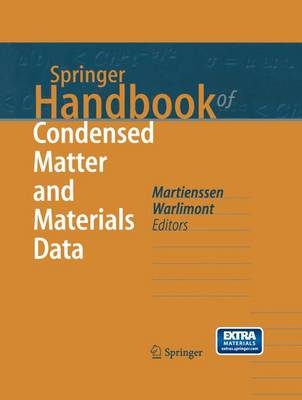
Springer Handbook of Condensed Matter and Materials Data / Springer Handbook of Condensed Matter and Materials Data
Springer Berlin (Verlag)
978-3-540-44376-6 (ISBN)
- Titel erscheint in neuer Auflage
- Artikel merken
The Handbook is designed to be useful as a desktop reference for fast and easy retrieval of essential and reliable data in the lab or office. References to more extensive data sources are also provided in the book and by interlinking to the relevant sources on the enclosed CD-ROM.
Physicists, chemists and engineers engaged in fields of solid-state sciences and materials technologies in research, development and application will appreciate the ready access to the key information coherently organized within this wide-ranging Handbook.
From the reviews:
"...this is the most complete compilation I have ever seen... When I received the book, I immediately searched for data I never found elsewhere..., and I found them rapidly... No doubt that this book will soon be in every library and on the desk of most solid state scientists and engineers. It will never be at rest." -Physicalia Magazine
Part 1 General Tables
Part 1 covers the fundamentals of the physics of condensed matter. Fundamental physical constants are qualitatively described and recently recommended numerical values are presented. A short review of The International System of Units (SI) is given and the concepts of base physical quantities and derived physical quantities on which the SI is founded is explained. A number of non-SI units which are still in use are also discussed. Periodic solids, which represent the major proportion of condensed matter are used to introduce briefly the basics of modern crystallography. A coherent introduction to the formalism required is given and the basic concepts and technical terms are briefly explained.
1.1 The Fundamental Constants
1.2 The International System of Units
1.3 Rudiments of Crystallography
Part 2 The Elements
Part 2 The Elements provides tables of the physical and physicochemical properties of the elements. Emphasis is placed on properties of the elements in the condensed state. The tables are structured according to the Periodic Table. Most of the tables deal with the properties of elements of one particular group of the Periodic Table. Only the elements of the first period (hydrogen and helium), the lanthanides, and the actinides are arranged according to the periods. This synoptic representation is intended to provide a transparent overview of the trends in the data.
Part 3 Classes of Materials
Part 3 Classes of Materials starts with the selective treatment of metals that are applied as base and alloying elements of metallic materials. According to common usage, the treatment of metallic materials is based on single elements and of groups of metals with common dominating features. The next class of materials discussed are ceramics. Detailed groupings and definitions of technical ceramics are given and traditional ceramics and cements, silicate ceramics, refractory ceramics, oxide ceramics, and non-oxide ceramics are treated. The physical and physicochemical properties of those polymers, copolymers, and polymer blends which are widely used for scientific applications and in industry are described in the next chapter. The last chapter serves as a source of data and commercial product information on glasses as engineering materials of practical importance.
3.1 Metals.- Magnesium and Magnesium Alloys.- Aluminium and Aluminium Alloys.- Titanium and Titanium Alloys.- Zirconium and Zirconium Alloys.- Iron and Steels.- Cobalt and Cobalt Alloys.- Nickel and Nickel Superalloys.- Copper and Copper Alloys.- Refractory Metals.- Noble Metals.- Lead and Lead Alloys
3.2 Ceramics
3.3 Polymers
3.4 Glasses
Part 4 Functional Materials
Part 4 covering functional materials is organized in a two-step approach. The first step corresponds to searching for the substance of interest, that is, the relevant group of substances. The second step corresponds to the physical property of interest. The subsections are characterized by the groups of the Periodic Table to which the constituent elements belong. For each group of substances, the physical properties are organized into four classes. These are: A Crystal Structure, Mechanical and Thermal Properties; B Electronic Properties; C Transport Properties; D Electromagnetic and Optical Properties. These property classes are further subdivided into individual properties. Materials covered are semiconductors, superconductors, magnetic materials, dielectrics and electrooptics, and ferro- and antiferroelectrics.
4.1 Semiconductors
4.2 Superconductors
4.3 Magnetic Materials
4.4 Dielectrics and Electrooptics
4.5 Ferroelectrics
Part 5 Special Structures
Part 5 covers special structures such as liquid crystals, solid surfaces and mesoscopic and nanostructured materials. The chapter on liquid crystals covers physical properties of the most common liquid crystalline substances as well as some liquid crystalline mixtures. Data compiled in the chapter on solid
| Reihe/Serie | Springer Handbook of Condensed Matter and Materials Data |
|---|---|
| Zusatzinfo | XVIII, 1121 p. |
| Verlagsort | Berlin |
| Sprache | englisch |
| Maße | 210 x 279 mm |
| Gewicht | 2405 g |
| Themenwelt | Naturwissenschaften ► Physik / Astronomie ► Atom- / Kern- / Molekularphysik |
| Schlagworte | alloy • Ceramics • Ceramics, Glasses, Polymers • Condensed Matter • Crystal • crystallography • Dielectrics and Electrooptics • Ferroelectrics • Functional Materials • liquid • liquid crystals • Magnetic Materials, Ferroelectrics • Materials Data • Materialwissenschaft • Metals and Alloys • Nanostructured Materials • Polymer • Semi- and Superconductors • Solid State Materials |
| ISBN-10 | 3-540-44376-2 / 3540443762 |
| ISBN-13 | 978-3-540-44376-6 / 9783540443766 |
| Zustand | Neuware |
| Informationen gemäß Produktsicherheitsverordnung (GPSR) | |
| Haben Sie eine Frage zum Produkt? |
aus dem Bereich



